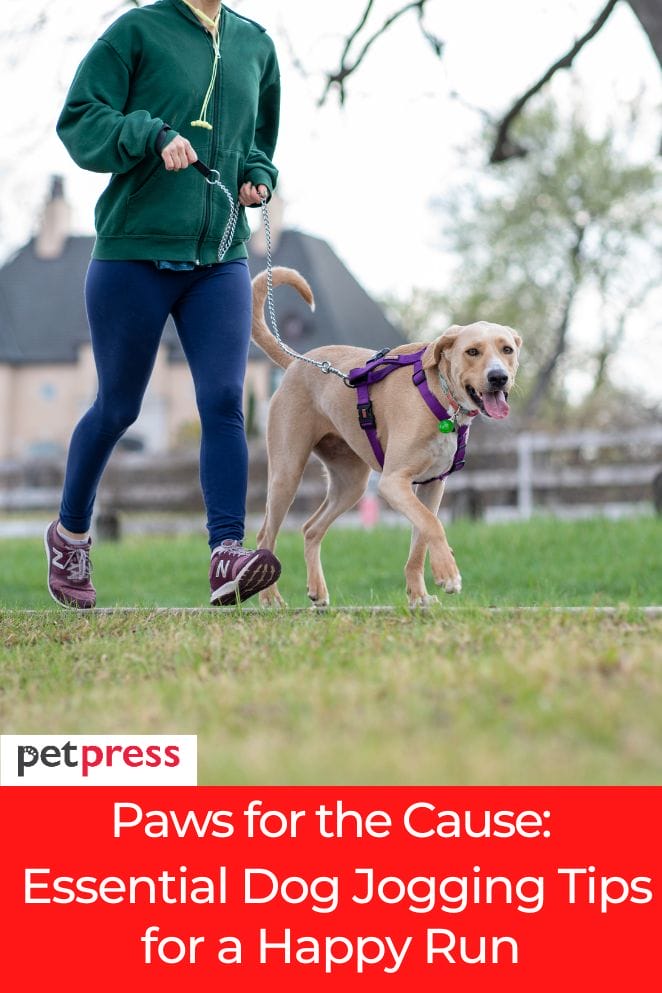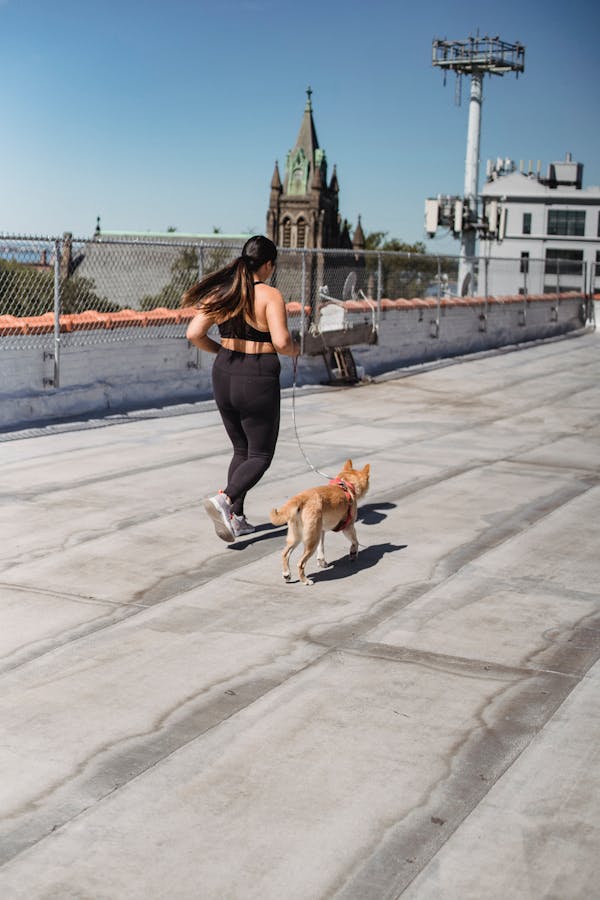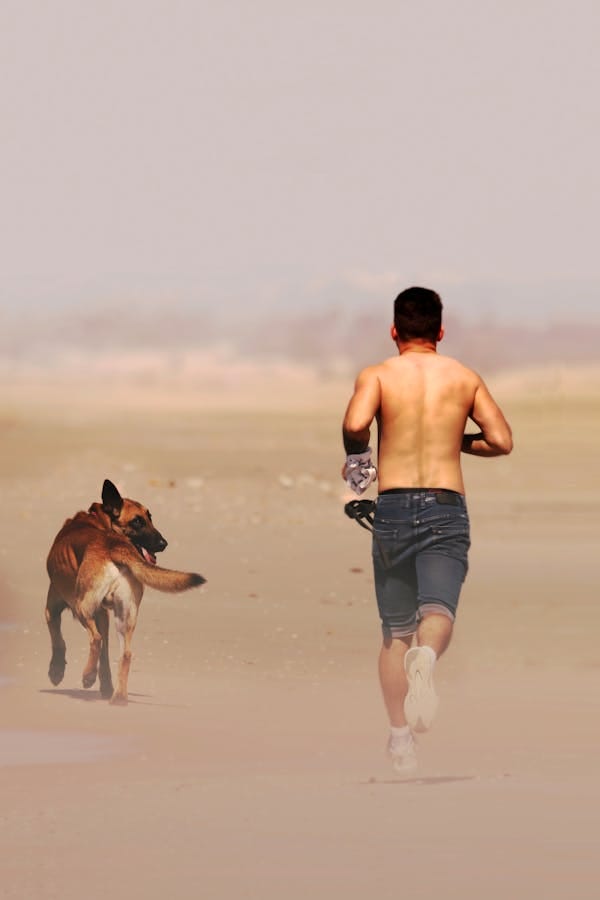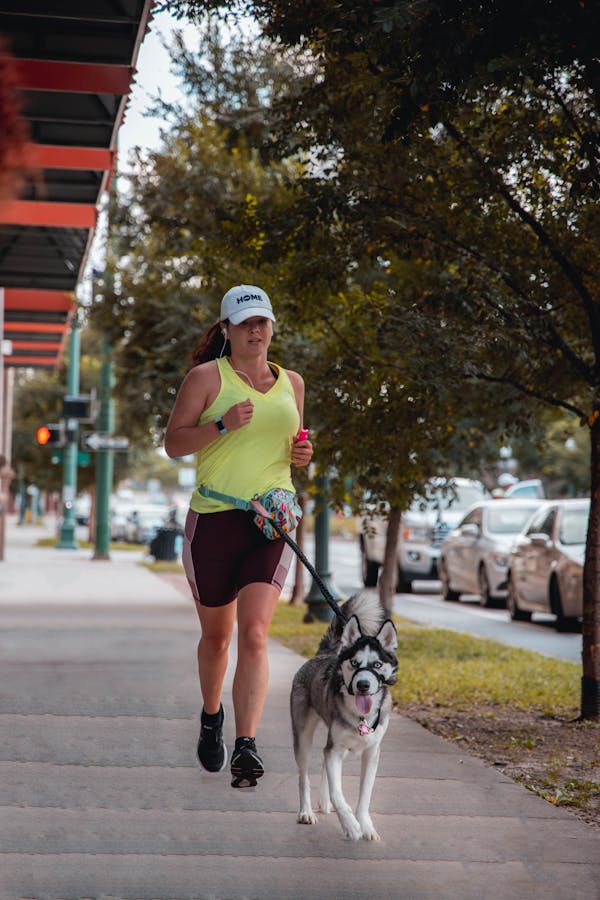
Dog jogging is a fun and healthy activity for both you and your furry friend.
It’s a great way to bond with your dog while also getting some exercise.
However, before you hit the pavement with your dog, there are a few things you need to consider to ensure a safe and enjoyable experience for both of you.
In this blog post, we’ll go over some tips for preparing your dog for jogging, assessing your dog’s fitness, and more.
Preparing Your Dog For Jogging
Preparing your furry friend for jogging can be an exciting adventure, but it’s crucial to ensure they’re ready for the activity.
Here’s what you need to know:
Assess your dog’s fitness
Before hitting the pavement, take a moment to evaluate your dog’s fitness level.
Consider factors such as their age, breed, and overall health.
Just like humans, not all dogs are built for intense workouts.
Older dogs or certain breeds with specific health concerns may need special considerations.
Consulting with your veterinarian can provide valuable insight into your dog’s capabilities.
Start slow and build gradually
Once you’ve determined that your dog is ready to jog, it’s essential to take it slow at the beginning.
Begin with short jogs and gradually increase the distance and speed over time.
This gradual progression allows your dog to adapt to the increased activity level and reduces the risk of injury.
Think of it as training for a marathon – you wouldn’t start with a 10-mile run on day one!
Choose a comfortable harness
Invest in a well-fitting harness designed specifically for jogging.
A good harness distributes the pressure evenly across your dog’s body, reducing strain on their neck and back.
Look for features like padded straps and adjustable fit to ensure maximum comfort.
Avoid using a collar for jogging, as it can strain your dog’s neck, especially if they pull or lunge.

Safety and Enjoyment
Ensuring safety and enjoyment for both you and your furry friend while jogging together is paramount.
Let’s delve into some key aspects to consider:
Choose the right route and time
Selecting a suitable route and time for your jog significantly impacts the experience.
Opt for paths that are safe and accommodating for both you and your dog, steering clear of busy roads and areas with potential hazards.
When planning your route, consider the time of day.
Early mornings or late evenings often offer cooler temperatures and fewer crowds, enhancing the comfort and safety of your jog.
Plan for hydration
Staying hydrated is crucial for both you and your dog during your jog.
Remember to bring along water bottles or a hydration pack for yourself, as well as a collapsible water bowl and sufficient water for your furry companion.
Offering water breaks throughout your jog helps prevent dehydration and ensures your dog’s well-being, especially on warm or humid days.
Watch for signs of fatigue
Vigilance is key to recognizing signs of fatigue in your dog while jogging.
Keep an eye out for indicators such as heavy panting, excessive drooling, or reluctance to continue.
These signals suggest that your dog may be reaching their physical limits and requires a break.
Pause your jog, allow your dog to rest, and assess their condition before deciding whether to continue or head back home.
Prioritizing your dog’s comfort and health fosters a positive experience for both of you.
Be mindful of temperature and weather
Consider environmental factors such as temperature and weather conditions when planning your jog.
Hot pavement can be uncomfortable or even harmful to your dog’s paws, so opt for shaded paths or cooler surfaces when possible.
Similarly, extreme heat or cold can pose health risks for your furry friend, so adjust your jogging schedule accordingly to ensure their safety and comfort.

Tips for Keeping Your Run Smooth
Ensuring a smooth and enjoyable jog with your dog involves more than just hitting the pavement.
Here are some additional tips to enhance your experience:
Train basic commands
Before venturing out for a jog, dedicate time to training essential commands with your dog.
Commands such as “heel,” “stay,” and “leave it” can help you maintain control and ensure your dog’s safety during the jog.
Practice these commands in various environments, gradually increasing distractions to reinforce your dog’s responsiveness.
Use positive reinforcement
Utilize positive reinforcement techniques to encourage desired behaviors from your dog during the jog.
Rewarding your dog with treats, praise, or play when they exhibit good behavior reinforces their training and strengthens the bond between you.
Be mindful of others
While on your jog, be considerate of other runners, cyclists, and pedestrians sharing the path.
Maintain a safe distance from others, particularly if your dog tends to get excited or distracted by passing individuals or animals.
Yield the right of way when necessary and communicate with fellow path users using verbal cues or hand signals.
Clean up promptly
Part of being a responsible dog owner is promptly cleaning up after your furry friend.
Carry waste bags with you during your jog and promptly dispose of any dog waste in designated bins.
Not only does this demonstrate good etiquette and respect for the environment, but it also ensures a clean and pleasant experience for fellow joggers and park visitors.

Conclusion
Jogging with your dog can be a fun and healthy activity for both of you.
By following these tips, you can ensure a safe and enjoyable experience for both of you.
Remember to start slow, choose a comfortable harness, and be mindful of your dog’s fitness level.
With a little preparation and caution, you can enjoy the benefits of dog jogging together.
FAQs
Dog jogging is a fun and healthy activity for both you and your furry friend. It’s a great way to bond with your dog while also getting some exercise.
Start by taking short walks with your dog, gradually increasing the distance and speed over time. This will help them get used to the idea of jogging and build up their stamina.
Consider your dog’s age, breed, and overall health. Older dogs and certain breeds may not be able to handle long jogs, so it’s important to start slow and build up gradually.
Look for a harness that fits well and provides good support for your dog’s neck and back.
Choose a safe route that’s free of traffic and other hazards, and avoid busy roads and parks during peak hours. Bring water for both you and your dog, and watch for signs of fatigue.


GIPHY App Key not set. Please check settings